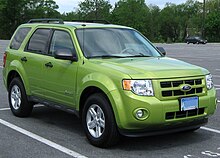Metric expansion of space
The metric expansion of space is the increase of distance between distant objects in the universe with time.
It is an intrinsic expansion—that is, it is defined by the relative separation of parts of the universe and not by motion "outward" into preexisting space. In other words, the universe is not expanding "into" anything outside of itself.
Metric expansion is a key feature of Big Bang cosmology and is modeled mathematically with the FLRW metric. This model is valid in the present era only at relatively large scales (roughly the scale of galactic superclusters and above). At smaller scales matter has clumped together under the influence of gravitational attraction and these clumps do not individually expand, though they continue to recede from one another. The expansion is due partly to inertia (that is, the matter in the universe is separating because it was separating in the past) and partly to the repulsive force of dark energy, which is of a hypothetical nature, but it may be the cosmological constant. Inertia dominated the expansion in the early universe, and according to the Lambda-CDM model (ΛCDM model) the cosmological constant will dominate in the future. In the present era they contribute in roughly equal proportions.
It is also possible for a distance to exceed the speed of light times the age of the universe, which means that light from one part of space generated near the beginning of the Universe might still be arriving at distant locations (hence the cosmic microwave background radiation). These details are a frequent source of confusion among amateurs and even professional physicists.
What space is the universe expanding into?
A graphical representation of the expansion of the universe with the inflationary epoch represented as the dramatic expansion of the metric seen below.
Over time, the space that makes up the universe is expanding. The words 'space' and 'universe', sometimes used interchangeably, have distinct meanings in this context. Here 'space' is a mathematical concept and 'universe' refers to all the matter and energy that exist. The expansion of space is in reference to internal dimensions only; that is, the description involves no structures such as extra dimensions or an exterior universe.
Finite space theory does not suppose space has an edge, but rather that space wraps around on itself. If it were possible to travel the entire length of space without going faster than light, one would simply end up back in the same place, like going all the way around the surface of a balloon (or a planet like the Earth).
The notion of more space is local, not global; we do not know how much space there is in total. The embedding diagram has been arbitrarily cut off a few billion years past the Earth and the quasar, but it could be extended indefinitely, even infinitely, provided we imagine it as curling into a spiral of constant radius rather than a circle. Even if the overall spatial extent is infinite we still say that space is expanding because, locally, the characteristic distance between objects is increasing.
A graphical representation of the expansion of the universe with the
inflationary epoch represented as the dramatic expansion of the metric seen on the left.
Hubble's law
Technically, the metric expansion of space is a feature of many solutions to the Einstein field equations of general relativity, and distance is measured using the Lorentz interval. This theoretical explanation provides a possible explanation of the observed Hubble's law which might indicate that galaxies that are more distant from us appear to be receding faster than galaxies that are closer to us.
In spaces that expand, the metric changes with time in a way that causes distances to appear larger at later times, so if our universe is a Big Bang universe, we would observe phenomena associated with metric expansion of space. If we lived in a space that contracted (a Big Crunch universe) we would observe phenomena associated with a metric contraction of space instead.
REALICE LAS ACTIVIDADES ENTRANDO A LOS COMENTARIOS DE ESTE TEXTO
REALICE LAS ACTIVIDADES ENTRANDO A LOS COMENTARIOS DE ESTE TEXTO




